Josef Sivic
ResidualViT for Efficient Temporally Dense Video Encoding
Sep 16, 2025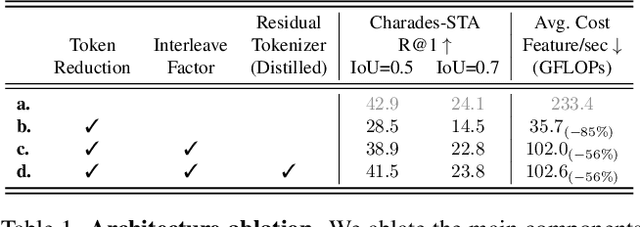

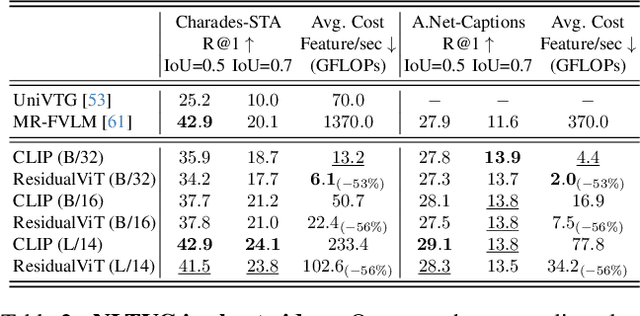

Abstract:Several video understanding tasks, such as natural language temporal video grounding, temporal activity localization, and audio description generation, require "temporally dense" reasoning over frames sampled at high temporal resolution. However, computing frame-level features for these tasks is computationally expensive given the temporal resolution requirements. In this paper, we make three contributions to reduce the cost of computing features for temporally dense tasks. First, we introduce a vision transformer (ViT) architecture, dubbed ResidualViT, that leverages the large temporal redundancy in videos to efficiently compute temporally dense frame-level features. Our architecture incorporates (i) learnable residual connections that ensure temporal consistency across consecutive frames and (ii) a token reduction module that enhances processing speed by selectively discarding temporally redundant information while reusing weights of a pretrained foundation model. Second, we propose a lightweight distillation strategy to approximate the frame-level features of the original foundation model. Finally, we evaluate our approach across four tasks and five datasets, in both zero-shot and fully supervised settings, demonstrating significant reductions in computational cost (up to 60%) and improvements in inference speed (up to 2.5x faster), all while closely approximating the accuracy of the original foundation model.
Discovering Divergent Representations between Text-to-Image Models
Sep 10, 2025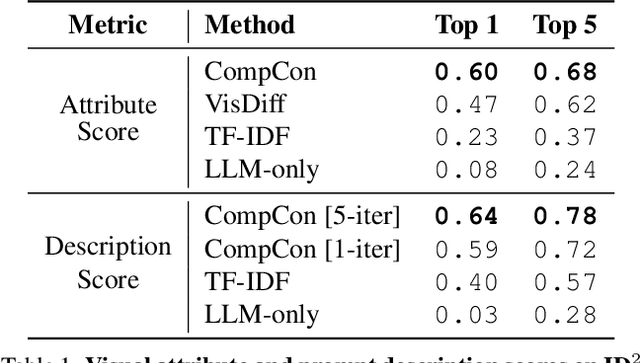
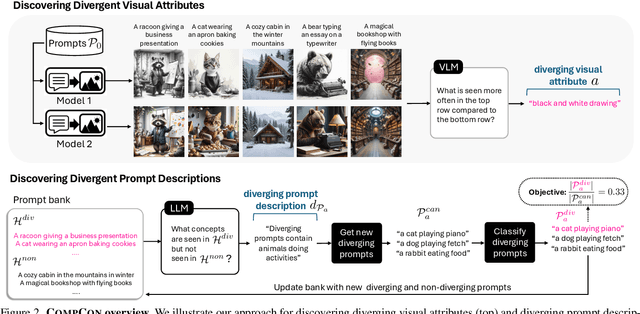
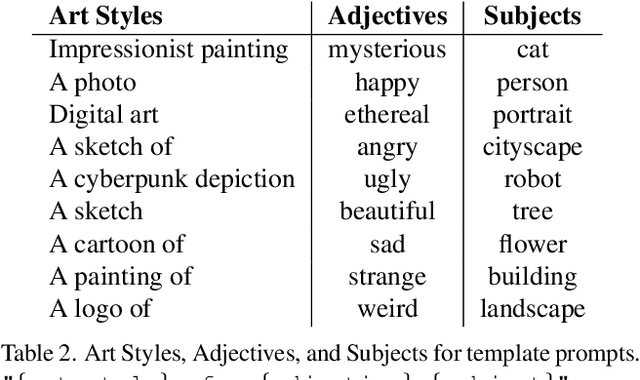
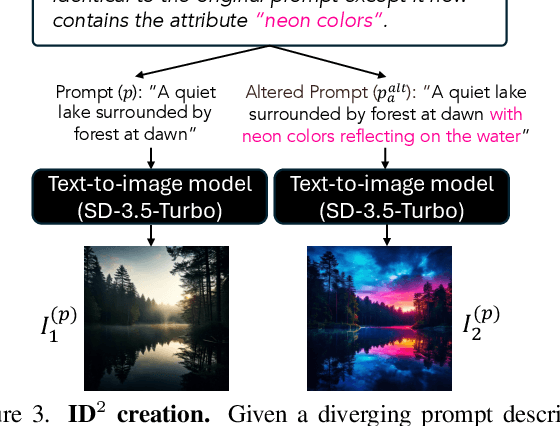
Abstract:In this paper, we investigate when and how visual representations learned by two different generative models diverge. Given two text-to-image models, our goal is to discover visual attributes that appear in images generated by one model but not the other, along with the types of prompts that trigger these attribute differences. For example, "flames" might appear in one model's outputs when given prompts expressing strong emotions, while the other model does not produce this attribute given the same prompts. We introduce CompCon (Comparing Concepts), an evolutionary search algorithm that discovers visual attributes more prevalent in one model's output than the other, and uncovers the prompt concepts linked to these visual differences. To evaluate CompCon's ability to find diverging representations, we create an automated data generation pipeline to produce ID2, a dataset of 60 input-dependent differences, and compare our approach to several LLM- and VLM-powered baselines. Finally, we use CompCon to compare popular text-to-image models, finding divergent representations such as how PixArt depicts prompts mentioning loneliness with wet streets and Stable Diffusion 3.5 depicts African American people in media professions. Code at: https://github.com/adobe-research/CompCon
Improving Personalized Search with Regularized Low-Rank Parameter Updates
Jun 11, 2025Abstract:Personalized vision-language retrieval seeks to recognize new concepts (e.g. "my dog Fido") from only a few examples. This task is challenging because it requires not only learning a new concept from a few images, but also integrating the personal and general knowledge together to recognize the concept in different contexts. In this paper, we show how to effectively adapt the internal representation of a vision-language dual encoder model for personalized vision-language retrieval. We find that regularized low-rank adaption of a small set of parameters in the language encoder's final layer serves as a highly effective alternative to textual inversion for recognizing the personal concept while preserving general knowledge. Additionally, we explore strategies for combining parameters of multiple learned personal concepts, finding that parameter addition is effective. To evaluate how well general knowledge is preserved in a finetuned representation, we introduce a metric that measures image retrieval accuracy based on captions generated by a vision language model (VLM). Our approach achieves state-of-the-art accuracy on two benchmarks for personalized image retrieval with natural language queries - DeepFashion2 and ConCon-Chi - outperforming the prior art by 4%-22% on personal retrievals.
Multi-step manipulation task and motion planning guided by video demonstration
May 13, 2025Abstract:This work aims to leverage instructional video to solve complex multi-step task-and-motion planning tasks in robotics. Towards this goal, we propose an extension of the well-established Rapidly-Exploring Random Tree (RRT) planner, which simultaneously grows multiple trees around grasp and release states extracted from the guiding video. Our key novelty lies in combining contact states and 3D object poses extracted from the guiding video with a traditional planning algorithm that allows us to solve tasks with sequential dependencies, for example, if an object needs to be placed at a specific location to be grasped later. We also investigate the generalization capabilities of our approach to go beyond the scene depicted in the instructional video. To demonstrate the benefits of the proposed video-guided planning approach, we design a new benchmark with three challenging tasks: (I) 3D re-arrangement of multiple objects between a table and a shelf, (ii) multi-step transfer of an object through a tunnel, and (iii) transferring objects using a tray similar to a waiter transfers dishes. We demonstrate the effectiveness of our planning algorithm on several robots, including the Franka Emika Panda and the KUKA KMR iiwa. For a seamless transfer of the obtained plans to the real robot, we develop a trajectory refinement approach formulated as an optimal control problem (OCP).
PhysPose: Refining 6D Object Poses with Physical Constraints
Mar 30, 2025Abstract:Accurate 6D object pose estimation from images is a key problem in object-centric scene understanding, enabling applications in robotics, augmented reality, and scene reconstruction. Despite recent advances, existing methods often produce physically inconsistent pose estimates, hindering their deployment in real-world scenarios. We introduce PhysPose, a novel approach that integrates physical reasoning into pose estimation through a postprocessing optimization enforcing non-penetration and gravitational constraints. By leveraging scene geometry, PhysPose refines pose estimates to ensure physical plausibility. Our approach achieves state-of-the-art accuracy on the YCB-Video dataset from the BOP benchmark and improves over the state-of-the-art pose estimation methods on the HOPE-Video dataset. Furthermore, we demonstrate its impact in robotics by significantly improving success rates in a challenging pick-and-place task, highlighting the importance of physical consistency in real-world applications.
Large-scale Pre-training for Grounded Video Caption Generation
Mar 13, 2025Abstract:We propose a novel approach for captioning and object grounding in video, where the objects in the caption are grounded in the video via temporally dense bounding boxes. We introduce the following contributions. First, we present a large-scale automatic annotation method that aggregates captions grounded with bounding boxes across individual frames into temporally dense and consistent bounding box annotations. We apply this approach on the HowTo100M dataset to construct a large-scale pre-training dataset, named HowToGround1M. We also introduce a Grounded Video Caption Generation model, dubbed GROVE, and pre-train the model on HowToGround1M. Second, we introduce a new dataset, called iGround, of 3500 videos with manually annotated captions and dense spatio-temporally grounded bounding boxes. This allows us to measure progress on this challenging problem, as well as to fine-tune our model on this small-scale but high-quality data. Third, we demonstrate that our approach achieves state-of-the-art results on the proposed iGround dataset compared to a number of baselines, as well as on the VidSTG and ActivityNet-Entities datasets. We perform extensive ablations that demonstrate the importance of pre-training using our automatically annotated HowToGround1M dataset followed by fine-tuning on the manually annotated iGround dataset and validate the key technical contributions of our model.
6D Object Pose Tracking in Internet Videos for Robotic Manipulation
Mar 13, 2025



Abstract:We seek to extract a temporally consistent 6D pose trajectory of a manipulated object from an Internet instructional video. This is a challenging set-up for current 6D pose estimation methods due to uncontrolled capturing conditions, subtle but dynamic object motions, and the fact that the exact mesh of the manipulated object is not known. To address these challenges, we present the following contributions. First, we develop a new method that estimates the 6D pose of any object in the input image without prior knowledge of the object itself. The method proceeds by (i) retrieving a CAD model similar to the depicted object from a large-scale model database, (ii) 6D aligning the retrieved CAD model with the input image, and (iii) grounding the absolute scale of the object with respect to the scene. Second, we extract smooth 6D object trajectories from Internet videos by carefully tracking the detected objects across video frames. The extracted object trajectories are then retargeted via trajectory optimization into the configuration space of a robotic manipulator. Third, we thoroughly evaluate and ablate our 6D pose estimation method on YCB-V and HOPE-Video datasets as well as a new dataset of instructional videos manually annotated with approximate 6D object trajectories. We demonstrate significant improvements over existing state-of-the-art RGB 6D pose estimation methods. Finally, we show that the 6D object motion estimated from Internet videos can be transferred to a 7-axis robotic manipulator both in a virtual simulator as well as in a real world set-up. We also successfully apply our method to egocentric videos taken from the EPIC-KITCHENS dataset, demonstrating potential for Embodied AI applications.
ShowHowTo: Generating Scene-Conditioned Step-by-Step Visual Instructions
Dec 02, 2024



Abstract:The goal of this work is to generate step-by-step visual instructions in the form of a sequence of images, given an input image that provides the scene context and the sequence of textual instructions. This is a challenging problem as it requires generating multi-step image sequences to achieve a complex goal while being grounded in a specific environment. Part of the challenge stems from the lack of large-scale training data for this problem. The contribution of this work is thus three-fold. First, we introduce an automatic approach for collecting large step-by-step visual instruction training data from instructional videos. We apply this approach to one million videos and create a large-scale, high-quality dataset of 0.6M sequences of image-text pairs. Second, we develop and train ShowHowTo, a video diffusion model capable of generating step-by-step visual instructions consistent with the provided input image. Third, we evaluate the generated image sequences across three dimensions of accuracy (step, scene, and task) and show our model achieves state-of-the-art results on all of them. Our code, dataset, and trained models are publicly available.
Generative Timelines for Instructed Visual Assembly
Nov 19, 2024Abstract:The objective of this work is to manipulate visual timelines (e.g. a video) through natural language instructions, making complex timeline editing tasks accessible to non-expert or potentially even disabled users. We call this task Instructed visual assembly. This task is challenging as it requires (i) identifying relevant visual content in the input timeline as well as retrieving relevant visual content in a given input (video) collection, (ii) understanding the input natural language instruction, and (iii) performing the desired edits of the input visual timeline to produce an output timeline. To address these challenges, we propose the Timeline Assembler, a generative model trained to perform instructed visual assembly tasks. The contributions of this work are three-fold. First, we develop a large multimodal language model, which is designed to process visual content, compactly represent timelines and accurately interpret timeline editing instructions. Second, we introduce a novel method for automatically generating datasets for visual assembly tasks, enabling efficient training of our model without the need for human-labeled data. Third, we validate our approach by creating two novel datasets for image and video assembly, demonstrating that the Timeline Assembler substantially outperforms established baseline models, including the recent GPT-4o, in accurately executing complex assembly instructions across various real-world inspired scenarios.
Grounded Video Caption Generation
Nov 12, 2024Abstract:We propose a new task, dataset and model for grounded video caption generation. This task unifies captioning and object grounding in video, where the objects in the caption are grounded in the video via temporally consistent bounding boxes. We introduce the following contributions. First, we present a task definition and a manually annotated test dataset for this task, referred to as GROunded Video Caption Generation (GROC). Second, we introduce a large-scale automatic annotation method leveraging an existing model for grounded still image captioning together with an LLM for summarising frame-level captions into temporally consistent captions in video. Furthermore, we prompt the LLM to track by language -- classifying noun phrases from the frame-level captions into noun phrases of the video-level generated caption. We apply this approach to videos from the HowTo100M dataset, which results in a new large-scale training dataset, called HowToGround, with automatically annotated captions and spatio-temporally consistent bounding boxes with coherent natural language labels. Third, we introduce a new grounded video caption generation model, called VideoGround, and train the model on the new automatically annotated HowToGround dataset. Finally, results of our VideoGround model set the state of the art for the new task of grounded video caption generation. We perform extensive ablations and demonstrate the importance of key technical contributions of our model.
 Add to Chrome
Add to Chrome Add to Firefox
Add to Firefox Add to Edge
Add to Edge